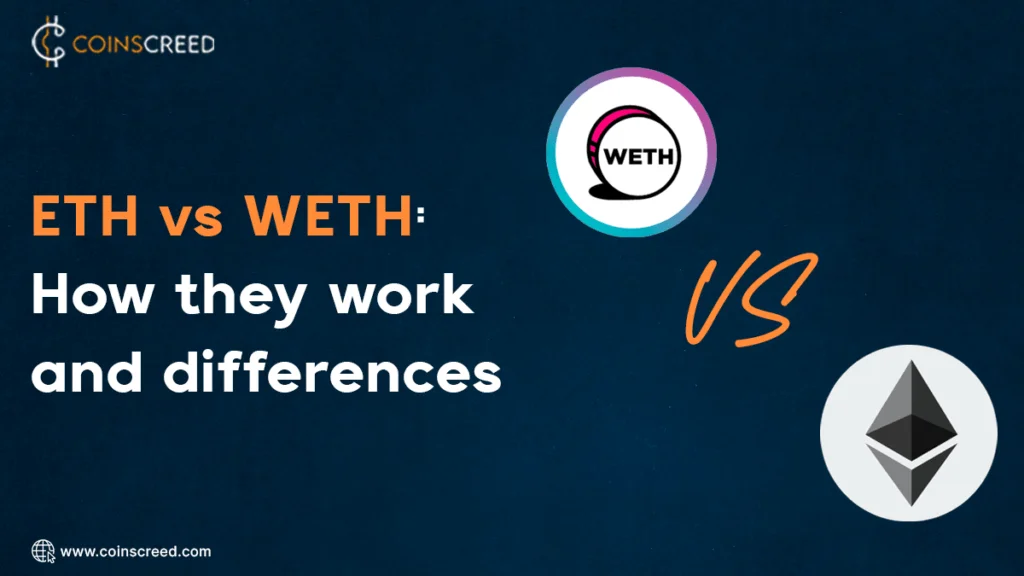ETH and WETH, what they are, how they work, and their differences. These are the topics treated in this article

ETH and WETH are concepts that need to be properly explained for crypto users to make the most of. When searching for NFTs on an NFT platform, you’ll notice that WETH can be used to make a purchase. How does WETH vary from ETH, and what does it do?
We must first understand ETH before we can progress toward that goal of understanding WETH. The cryptocurrency used within the Ethereum network is called Ether (ETH for short). It’s used for transacting in Ethereum and carrying out contracts on the network.
Wrapped Ether (WETH) is an ether-backed token. To put it simply, it’s a “container” for Ethereum that follows the ERC-20 protocol.
We’ll go through WETH, how it differs from ETH, and how to wrap and unwrap ETH in this piece.
Ethereum (ETH)

Ethereum may be broken down into its parts, the first of which is a global decentralized software platform powered by blockchain technology. Most people are familiar with it because of its in-house cryptocurrency, known as ether (ETH).
Anyone can utilize Ethereum as a tool to construct any type of secured digital technology. In addition to being able to use it as payment for ‘labor done supporting the blockchain,’ participants in the network will also be able to use the token, if accepted, to pay for physical products and services.
Ethereum was developed with the goals of being scalable, programmable, decentralized, and secure. It is the blockchain of choice for software developers and businesses that are developing a technology based on it to transform the way many different industries function and how we go about our daily lives.
Features of ETH
- Ether: This is the name of the cryptocurrency that functions on the Ethereum network.
- Smart contracts: They can be developed and deployed on Ethereum thanks to the platform’s capabilities in this area. The transaction of any valued asset between two parties can be facilitated through the use of straightforward computer software known as a smart contract. It might be money, shares, property, or any other digital item that people wish to exchange. People also desire to trade in analog assets.
- Ethereum Virtual Machine: Ethereum supplies the underlying technology, the architecture, and the software that understands smart contracts and enables people to interact with them. Ethereum is also the name of the cryptocurrency that Ethereum runs on.
- Decentralized applications (also known as Dapps): Ethereum enables users to construct consolidated programs that are referred to as decentralized applications. A Dapp, which can alternatively be spelled DAPP, App, or DApp, is the abbreviated form of the term “decentralized application.”
- Users of Ethereum can build decentralized autonomous organizations, often known as DAOs, to engage in democratic decision-making. DAOs are decentralized autonomous organizations that function in complete transparency and are unaffected by any outside action.
Wrapped Ethereum (WETH)

Wrapped Ether is abbreviated as WETH. WETH is a version of Ethereum that is compatible with ERC-20. There will never be a day when 1 ETH does not equal 1 WETH. It is not possible to obtain pre-approval (no approval) for the use of ETH solely to place bids on products. Because of this, it needs to be wrapped.
When Ethereum has been “wrapped” in WETH, it will be possible to use it for more complex interactions on decentralized applications such as LooksRare. Additionally, the utilization of WETH makes it possible to standardize the exchange codebase (for the potential support of additional ERC-20 tokens). It also assists in mitigating risks such as reentrancy (and other costly fallbacks), which may occur with the transfer of ethers to unidentified third parties (e.g., the ask side of the trade).
Advantages of WETH
- WTH is more liquid than ETH since its value is guaranteed by a custodian (like smart contracts).
- To ensure the safety of their holdings, WETH custodians often employ encrypted exchanges, making WETH a safer option than ETH. When the private keys are safely stashed away, you get greater authority over the tokens.
- It features lower transaction costs than ETH and a faster transaction speed.
Similarities between ETH and WETH
ETH and WETH are distinct cryptocurrencies, although they have the same value (i.e., a 1:1 swap ratio). WETH is an ERC-20 token that functions in the same way as ETH does. This indicates that Wrapped Ether possesses the same qualities and characteristics that Ether does.
An ERC-20 compatible token can connect with other tokens issued on the Ethereum blockchain without the need for a third-party application thanks to ERC-20, a technical standard protocol.
Wrapped Ether was developed so that problems with ETH’s interoperability might be solved. Not only are users able to make use of WETH tokens outside of the Ethereum network, but they can also develop their very own customized copies of the coins to use in their unique DeFi applications.
There is no price differential between ETH and WETH since the wrapped tokens, also known as WETH, are always exchanged at a ratio of 1:1. This means that the wrapped tokens have the same value as ETH.
To put it another way, if you want to make use of your Ethereum tokens in a decentralized application (DApp) or a decentralized financial ecosystem, you can easily convert them into wrapped tokens and keep making use of them.
Differences between ETH and WETH
Unlike ETH, WETH adheres to a standard that is known as ERC-20. ETH, on the other hand, does not. As a result of the impracticality of employing ETH across a variety of DeFi applications, WETH was developed.
Therefore, encasing the ETH token in an ERC-20 compatible standard made it possible for it to be widely used across a wide variety of decentralized applications (dApps). This also means that users can build their unique versions of tokens for use in the DeFi applications they have developed.
Now, concerning WETH, we may say that it is the same thing as ETH. That there is no difference in price between ETH and WETH is a consequence of this fact. Therefore, if you want to utilize your ETH to take part in a custom decentralized application (dApp), you may easily convert it into WETH on a decentralized application (dApp) such as 1inch, and then continue to use it.
Keep in mind that the ERC-20 token standard is a technical specification for implementing token issuance on the Ethereum blockchain.
It is exclusively responsible for dictating the characteristics of the token. Fungibility is one of the most important characteristics of an ERC-20 token since it ensures that a given token may always be traded in for another token of the same value. This ensures that the token’s value is stable.
The Operation of WETH
Now that we are familiar with the distinction between ETH and WETH, let’s move on to gaining an understanding of how wrapped tokens to function. Sending the native asset to a centralized custodian is the standard procedure to follow whenever you wish to generate a wrapped version of any token (ideally a smart contract).
This centralized entity might be anything from a multisig wallet to a decentralized autonomous organization (DAO), or even just a smart contract (in the case of Ethereum). The procedure is explained in more detail below.
Assume for the moment that you have no choice but to utilize WETH on Ethereum. If this is the case, all you need to do is link the wallet where you keep your Ethereum to a decentralized trading platform such as 1inch.
After you have successfully connected your wallet, the next step is to determine how much ETH you wish to transform into WETH and then exchange the tokens.
Therefore, in exchange for the ETH that you have sold, you will receive WETH. You are free to apply this to any decentralized application of your choosing.
This process would be straightforward for a centralized entity in the sense that as soon as they obtained a native asset, they would destroy it and mint a wrapped version of it on a blockchain that was not native to the asset. When the user is ready to convert the non-native asset back to their original one, all they have to do is burn the wrapped asset and mint the native item on their original network.
Conclusion
All wrapped tokens have the same overarching goal, which is to essentially offer another layer of interoperability between the many different networks. Converting a non-native asset such as BTC to an ERC-20 compatible token (such as USDT) and then converting that token to WBTC is not a logical course of action for the vast majority of consumers.
They will typically conduct the vast majority of their business with nothing more than their supply of USDT. However, the goal of WETH is to provide users of native ETH with a more streamlined and intuitive experience.

